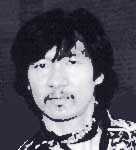Martin Wong
| Martin Wong | |
|---|---|
 | |
| Born |
11 July 1946 Portland, Oregon |
| Died |
12 October 1999 (aged 53) San Francisco, California, USA |
| Known for | Painting, Drawing, Sculpture, Printmaking, Ceramics |
Martin Wong (11 July 1946 – 12 August 1999) was a U.S. painter of the late twentieth century.
Biography
Early years
Wong was born in Portland, Oregon and raised in the Chinatown district of San Francisco, California. He studied ceramics at Humboldt State University, graduating in 1968. Through college and for another 10 years he was active in the San Francisco Bay Area art scene, including stints as a set designer for the performance art groups The Cockettes and Angels of Light. He was openly gay.[1]
In 1978 he moved to Manhattan, eventually settling in the Lower East Side, where his attention turned exclusively to painting. According to Wong, his move to New York was precipitated by a friendly challenge:
| “ | I made ceramics and did drawings at arts fairs. I was known as the 'Human Instamatic.' It was US$7.50 for a portrait. My record was 27 fairs in one day. Friends said to me, 'If you're so good, why don't you go to New York?'[2] | ” |
Career
Wong's mature work ranged from gritty, heartfelt renderings of the decaying Lower East Side, to playful, almost kitschy depictions of New York's and San Francisco's Chinatowns, to "traffic signs for the hearing impaired". He is perhaps best known for his collaborations with Nuyorican poet Miguel Piñero, paintings that often combined Piñero's poetry or prose with Wong's painstaking cityscapes and stylized fingerspelling.[3] Wong's Loisaida pieces and collaborations with Piñero form part of the Nuyorican arts movement.
Wong was a collector and connoisseur of everything from graffiti to Asian antiquities. For a time in the 1980s he made ends meet by buying underpriced antiquities at Christie's and selling them at Sotheby's for a fairer price.[2] His graffiti collection grew to be perhaps the largest in the world; in 1994 he donated it to the Museum of the City of New York.
Once nearly overlooked by the art establishment, Wong was acknowledged in his New York Times obituary as an artist "whose meticulous visionary realism is among the lasting legacies of New York's East Village art scene of the 1980s".[4] Critical esteem has sustained since his death, and Wong's works can be found in collections worldwide, including the collections of the Metropolitan Museum of Art, the de Young Museum and the cities of New York and San Francisco. The Martin Wong Papers reside at the Fales Library, New York University, and include among other things sketchbooks, correspondence, biographical documents, videocassette recordings, photos, graffiti-related materials, and parts of Wong's personal library.
The catalog of a joint exhibition of Wong's work at the New Museum of Contemporary Art and the Illinois State University Galleries was published by Rizzoli in 1998 in Sweet Oblivion: The Urban Landscape of Martin Wong.
Two of Martin Wong's paintings are in the collection of the Whitney Museum in New York City. One of his paintings is in the collection of the state of California and displayed permanently at the California State Building in San Francisco. The Society of Contemporary Art at the Art Institute of Chicago acquired the painting "Sweet Oblivion" in May 2012.
Personal life
Wong died in San Francisco from an AIDS related illness in 1999.[4] His former partner, Miguel Piñero, credited with his success in the barrios of New York City, died a decade earlier in 1988.
References
- ↑ Mann, Richard G (4 July 2007). "Wong, Martin". glbtq.com. Retrieved 2007-10-15.
- ↑ 2.0 2.1 "The Bricklayer's Art", by Guy Trebay, May 26, 1998, The Village Voice
- ↑ Mallory Curley, A Cookie Mueller Encyclopedia (Randy Press, 2010)
- ↑ 4.0 4.1 Roberta Smith (18 August 1999). "Martin Wong Is Dead at 53". The New York Times. Retrieved 2008-10-26.
External links
- http://dlib.nyu.edu/findingaids/html/fales/wong.html The Fales Library of NYU's Guide to the Martin Wong Papers
- Art Inside the HSU Library
- Martin Wong's page at artnet.com, including pictures of his work
- Public art project completed while resident at NYC Department of Transportation
- Public art project for Percent for Art in NYC
- The Martin Wong Graffiti Collection at the Museum of the City of New York
|